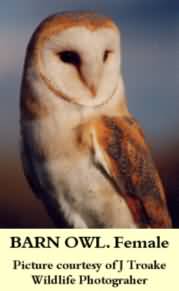
IDENTIFICATION. Perhaps the most beautiful of owls, the Barn Owls scientific name translates as 'nocturnal owl that is white'. White belly and facial discs with mixtures of golden buff and blue grey on the head, back and wings. Males tend to be whiter than the females which have more speckling on the breast feathers.
Sometimes confused with the much larger and rarer Snowy Owl.
IN FLIGHT. The flight is low and buoyant with wing beats varying from a moth like slow to quite fast. Often seen quartering fields and hovering whilst looking for rodents. Quick angled turns allow the Barn Owl to drop onto unsuspecting prey.
DISTRIBUTION. A decreasing population, due in part to the change in agricultural trends. Prefers open grass farmland with ditches, streams and hedgerows. The Barn Owl, although becoming rarer, can be seen across much of the British Isles with the exception of the Highlands of Scotland, Wales and North England.
WHEN SEEN. All year round.
FOOD. Small mammals to the size of rats and weasels, predominantly short tailed field voles and shrews. Insects are also taken, along with the occasional frog.
BREEDING. April - May. 4 to 6 eggs laid in a scrape amongst disgorged, maggot infested, pellets (how they avoid infection I will never know!). The ‘nest’ is usually sited in an old building, tree hole or rock face. Young hatch after 33 days, flying 9-12 weeks later.
SIZE. 34cm (13in)
WINGSPAN. 76cm (30in)
WEIGHT. 340g (12oz)
CALL. Varies from a hissing to a chirring noise. Around breeding time a snore may be heard. Barn Owls do not make a hooting call like other owls.
FALCONRY.
I
t is believed that there are more Barn Owls in captivity in Britain than in the wild. Whether this is a good thing or not is debatable. Like Kestrels and Sparrowhawks the low weight of a Barn Owl can make them prone to going underweight when flown and therefore easily killed if not flown by an experienced falconer. If a Barn Owl is to be kept they need a good size aviary, not a parrot cage, and company if not flown regularly.Beware - if you have a breeding pair of Barn Owls they can produce a great deal of offspring. It is illegal to release Barn Owls into the wild without special licences so GOOD homes need to be found for them. If you wish to keep Barn Owls a same sex pair may be a better proposition. It is always best to be aware that however much you trust your owl, it is still an animal and could therefore be unpredictable if poorly treated. Coming into the breeding season or if it is just having a bad day can result in scratches, bites or worse.
NB. If you buy one of these raptors it should be fitted with a closed leg ring and have an Article 10 form with it (any queries check with DEFRA).
Falconry marks
![]()